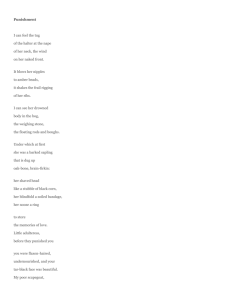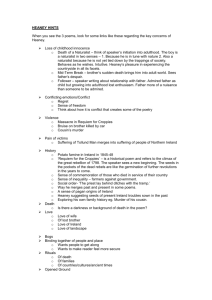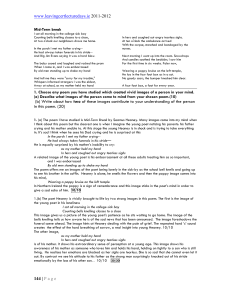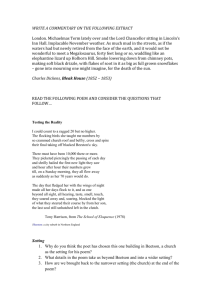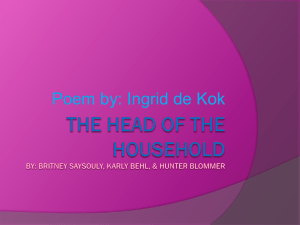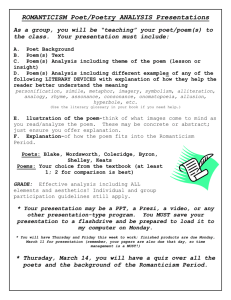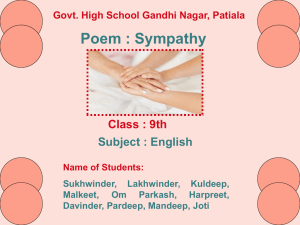Punishment by Seamus Heaney – Analysis notes
advertisement
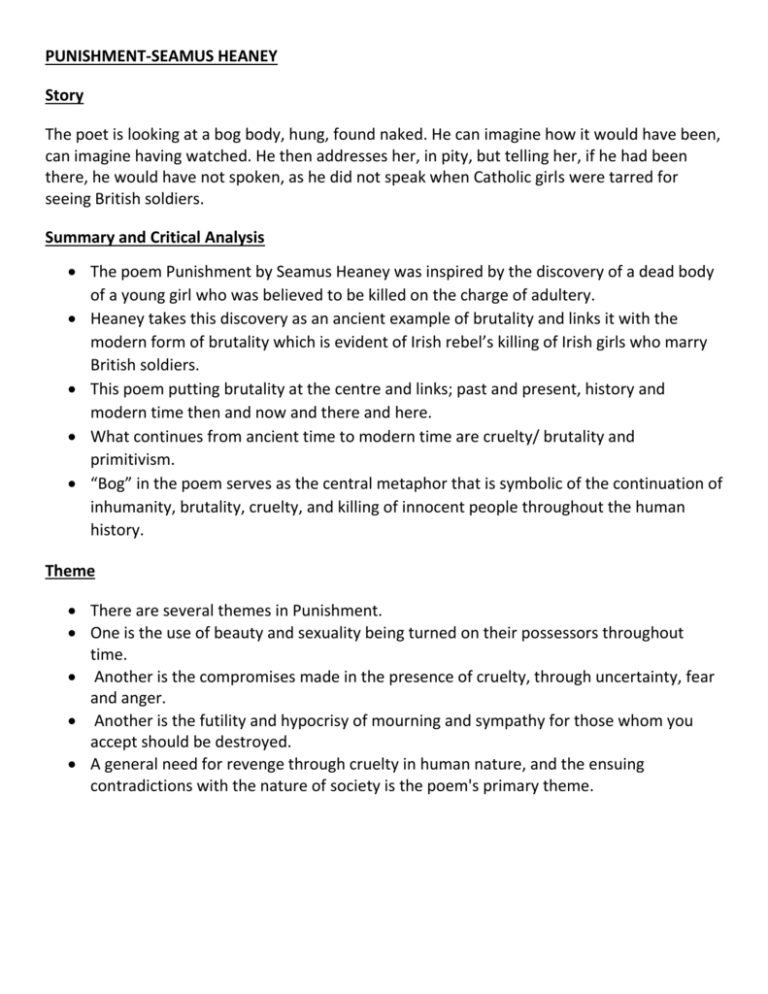
PUNISHMENT-SEAMUS HEANEY Story The poet is looking at a bog body, hung, found naked. He can imagine how it would have been, can imagine having watched. He then addresses her, in pity, but telling her, if he had been there, he would have not spoken, as he did not speak when Catholic girls were tarred for seeing British soldiers. Summary and Critical Analysis The poem Punishment by Seamus Heaney was inspired by the discovery of a dead body of a young girl who was believed to be killed on the charge of adultery. Heaney takes this discovery as an ancient example of brutality and links it with the modern form of brutality which is evident of Irish rebel’s killing of Irish girls who marry British soldiers. This poem putting brutality at the centre and links; past and present, history and modern time then and now and there and here. What continues from ancient time to modern time are cruelty/ brutality and primitivism. “Bog” in the poem serves as the central metaphor that is symbolic of the continuation of inhumanity, brutality, cruelty, and killing of innocent people throughout the human history. Theme There are several themes in Punishment. One is the use of beauty and sexuality being turned on their possessors throughout time. Another is the compromises made in the presence of cruelty, through uncertainty, fear and anger. Another is the futility and hypocrisy of mourning and sympathy for those whom you accept should be destroyed. A general need for revenge through cruelty in human nature, and the ensuing contradictions with the nature of society is the poem's primary theme. Punishment I can feel the tug of the halter at the nape of her neck, the wind on her naked front. It blows her nipples to amber beads, it shakes the frail rigging of her ribs. I can see her drowned body in the bog, the weighing stone, the floating rods and boughs. Under which at first she was a barked sapling that is dug up oak-bone, brain-firkin: her shaved head like a stubble of black corn, her blindfold a soiled bandage, her noose a ring to store the memories of love. Little adulteress, before they punished you you were flaxen-haired, undernourished, and your tar-black face was beautiful. My poor scapegoat, I almost love you but would have cast, I know, the stones of silence. I am the artful voyeuur of your brain’s exposed and darkened combs, your muscles’ webbing and all your numbered bones: I who have stood dumb when your betraying sisters, cauled in tar, wept by the railings, who would connive in civilized outrage yet understand the exact and tribal, intimate revenge. In the first, second, and third stanzas the poet using his sympathetic imagination describes the way the girl was punished on the charge of adultery. He creates the picture of a weak and fragile girl and seems to be suffering her pain and agonies. When the girl was punished, she was pulled her with a rope from her neck, she was made to go naked. The girl was trembling with cold, her whole body was shaking. She was behaved as if she was not human and non-living. They used an old knife to shave her head. Her eyes were blindfolded so that she could not see the world. Instead of a ring they gave her a noose. And finally she was buried alive. The stones, rods and boughs were used to cover the bog. In the fifth and seventh stanza the poet beautifies the dead body and attempts to create a mental picture of the girl, when she was alive. He compares ‘shaved head’ to ‘stubble of black corn”, the noose to a “ring” and he imagines a beautiful picture of the girl as flaxen (silky) haired and with a beautiful tarblack face. The poet shows his sorrow and pity to the girl by saying “My poor scapegoat” which indicates she alone is the victim of the so-called crime of adultery since her partner is not punished because he is male. She alone is punished for their so called criminal act, she became a scapegoat. In the sixth stanza the poet makes it clear that she was killed on the charge of adultery, but this adultery for doing “love” is not a crime. In the eighth stanza the poet shows his ambivalent attitude regarding his relation to that girl. On the one hand he claims to be in love with that girl but on the other hand he shows his helplessness that he could do nothing to save the girl. This stanza raises the serious question about the role of an artist in a situation in which innocents are victimized. For, Heaney this role is the role of a “voyeur” who can observe the scene from a distance only to draw it artistically. In stanzas nine and ten of the poem, the poet repeats the same role of passive observer and links past and present. He compares the brutality of tribal men of the first century AD and brutality of the Irish Revolutionary Army. What he observes is that the perpetrators are different but the form of brutality is the same. In both past and present innocents are victimized for the crime. In Ireland Irish girls who married British soldiers were brutally killed by Irish Revolutionary Armies. The marriage between and Irish girl and British soldiers was viewed as an act of betraying Irish nationalism or Irish Revolution as suggested by the term “your betraying sisters”. The poet seems to be mocking the claim of modern men being civilized. Though there is a constant claim of civilization but the base of it is constituted by atrocity, brutality, inhumanity and cruelty. Structure The poem has eleven stanzas, each with four short lines. The poem is enjambed across both lines and stanzas, destroying the rhythm that would be implied by such a structure. Even with the enjambment, the pauses in the poem are breathless, each description as short as possible. There is no rhyme in the poem. Heaney uses prose punctuation for the poem, using full stops only after capitals. Language The language in the first two stanzas is visual, and anatomical. Often the images are natural. Diction The first part of the poem (up to the third line of the sixth stanza, exactly half way through) is in the third person - describing the woman to another, or to himself Heaney focuses on her, on her body and death. The second part of the poem, although addressed in the second person to her - "Little adulteress... my poor scapegoat", is actually focused upon Heaney himself. Tone The use of the third person in the first four stanzas produces a tone of gentle sadness she is frail and cold, but nameless, person less and distant. The violence of "her shaved head... her blindfold a soiled bandage,/her noose a ring" makes the tone more forceful, more powerful. The violence is softened in the second person address. "under nourished... scapegoat" are addresses of pity, and the vague "they" who punish are kept at a, not neutral, but impersonal distant. In the last three stanzas Heaney's thoughts are on himself, and he is not angry, but confused, hesitant and rather detached. Mood The opening is surprisingly peaceful, brought about by the focus on the girl's body, and the method of execution held in the background. The mood becomes violent in the fifth stanza, but the personal expression of love and desire transforms the mood into that of a lament. Heaney's emotional ambiguity, expressed in the last three stanzas, and especially the last, brings about an uncertain mood, confused and helpless. Poetic Devices Double alliteration - "halter... nape... her neck... her naked... her nipples" Alliteration - "body... bog", "stones of silence", "shaved... stubble", "blindfold... bandage". Metaphor - "the halter [=noose]", "nipples... amber beads", "the frail rigging of her ribs", "she was a barked sapling", "her blindfold a soiled bandage", "her noose a ring/to store/the memories of love", "scapegoat", "your brain's exposed/and darkened combs", "your muscle's webbing" Kennings (A kenning is a much-compressed form of metaphor, originally used in Anglo-Saxon and Norse poetry. In a kenning, an object is described in a two-word phrase, such as 'whaleroad' for 'sea'. Some kennings can be more obscure than others, and then grow close to being a riddle.) "oak-bone", "brain-firkin", "flaxen-haired", "tar-black" Simile - "her shaved head/like a stubble of black corn" Imagery The image of the body occupies most of the poem. It is mostly described in metaphor and simile, and is composed of numerous sub-images. The body is first associated with a sea-storm, with wind, and "rigging", the descriptions emphasizing frailty. The images of the death itself are heavy, eg "the weighing stone", and the bog itself, which kill not only the girl but "the floating rods and boughs". The imagery of the found body, although the tree metaphor continues, is more literal as the hair and bandage are visual descriptions. Heaney then presents his own imagination, and its products as imagery. He uses the image of his own desire to draw himself closer to the long-dead girl. Now he begins with the description of her in his mind's eye, and ends with his morals. Heaney and his actions are the primary image of the poem's second half. It is his own virtual voyeurism he focuses on. The image of the girl becomes cliched. The final non-mental image is of the contemporary Irish Catholic girls, tarred for seeing British soldiers. Heaney understands their pain, as dramatized in the bog body, and understands also the need for revenge.
